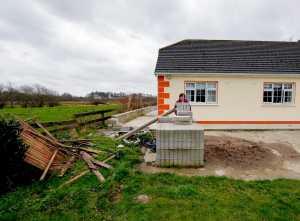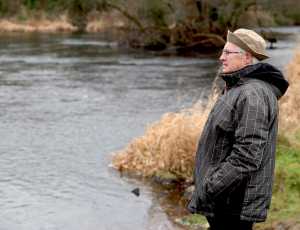
THE small rural area of Springfield in Clonlara made national headlines in the winter of 2015 as floods swept through the Shannon Basin. Kathy Masterson visits the area to find out what’s been happening in the meantime.
IN DECEMBER 2015, the lives of a group of residents in Springfield, Clonlara were plunged into chaos as floodwaters rose around their homes.
Locals worked day and night alongside army personnel and Clare County Council staff to keep the water from reaching their doors.
At the time, a general election was looming and government representatives were tripping over themselves to visit Springfield to be photographed walking the roads in waders and making grand promises to residents. Among these was the then Agriculture Minister Simon Coveney, who assured the people of Springfield that they “won’t be forgotten about” as the government “has an onus” to help them.
It has been just over a year since the waters receded, but for those affected by the 2015/16 flooding, the threat of a repeat occurrence is omnipresent.
The Limerick Post visited Springfield this week to find out if any of the promises made last year have been kept.
Geraldine Quinlivan, whose home was one of two that were flooded in 2015, along with a third property that was unoccupied, says that until last week, residents had no update from the Office of Public Works (OPW) since October 2016.
“The owners of nine houses here applied for funding for flood defences, but all nine were turned down by the OPW on the grounds that it wasn’t cost effective,” she said.
Geraldine and her husband Joe have started to build a flood protection wall around their home with their own money, as they have yet to receive any assistance from the government.
“When it’s finished it’s going to be about two and a half feet high. We started at the corner of the house where the water hits first. We have to use all our own resources to build it.
“We’re being proactive because it doesn’t seem as though anybody else is. This threat hangs over us every year. We have to do something to give ourselves some kind of peace of mind, because it doesn’t look as if anybody else is doing anything.
“Even now, one year later, this is still taking over our lives. Joe is building this wall on Saturdays and Sundays when he’s off work, as we can’t afford a bricklayer. It’s awful to see my husband out there putting up the wall. He’s meant to be relaxing after a week’s work, and instead he’s building a wall. He’s so worried about his family that he feels he has to do it,” she explained.
The Quinlivans were hit by flooding both in 2009 and in 2015. Thankfully, last year the damage was not as severe, due to what Geraldine calls the “superhuman efforts” of Joe and the couple’s four sons.

Geraldine Quinlivan beside the wall the family is building as a flood defence. Picture: Keith Wiseman
In between the 2009 and 2015/16 flooding events, the OPW commissioned a study by Jacobs Engineering Ireland for the entire Shannon Basin, known as the Shannon CFRAMS study (Catchment Flood Risk Assessment and Management Study).
The study identified three options for flood defences at Springfield, but all of these were deemed to be non-runners according to the cost-benefit analysis.
However, local councillor Michael Begley says that Clare County Council has disputed the findings, as, crucially, the statistics surrounding the 2015/16 flooding event were not taken into account.
Cllr Begley and the Springfield residents hope that the OPW will approve one of the three options when it completes an update of the study in the coming weeks using the 2015/16 facts and figures.
This option would involve the construction of an earthen embankment to prevent a channel of flooding from occurring.
“This would be a distance of about 1.2 kilometres, which is not huge in the scheme of things. The height to be achieved would be about two and a half metres, again that wouldn’t be big in the scheme of things. That would have prevented Springfield’s flooding, but obviously the cost of that is what was in dispute.
“Clare County Council proposed last May to hire a consultant independently to assess this one option. The OPW took four months to say that they wouldn’t fund that because they already had consultants in place,” said the Independent councillor.
Cllr Begley also revealed that the cost-benefit analysis “took the cold fact that two houses, and one that was unoccupied, flooded”, however a further nine houses would have flooded “only for the manpower, the materials, the pumping, everything like that that was done to save them”.
“On top of that, there are another five houses that weren’t flooded, but were inaccessible. The road leading to those five houses was under a metre and a half of water. Not even the biggest tractor in the parish was able to get through it,” he added.
“If you were to take those statistics, and reapply the formula to include 17 houses, it would produce a totally different cost ratio.
“If that were to pan out as we think it would, we would probably be left with half of the estimated cost of €1.4 million, about €600-€700,000. Then you’re close to your goal for the Minor Works Scheme, which is funded by the OPW but was handed over to the local authorities around mid 2015. The council would be happy with that because then as soon as they get the money, they can get on with the job.”
According to the local representative, this would be money well spent as the combined cost of defending homes in Springfield from flooding in 2009 and 2015/16 was in the region of €600-€700,000, taking into account the cost of the manpower, materials such as sandbags and pumps, and alternative accommodation for householders.
If funding is approved, Cllr Begley believes the local authority can complete the work in four to six months, and that the embankment “would probably rid Springfield of water completely”.

In October 2016, the OPW agreed with Clare County Council that they would ask Jacobs Engineering Ireland to review the Springfield proposal.
“We had hoped that we might hear something on this prior to Christmas, but that hasn’t happened. We’re disappointed that it’s taken a full year and we can’t get a simple answer from the people who are supposed to have all the information in front of them. In the meantime it could happen again. Most years you will get some amount of flooding, this year we were lucky that the rainfall was very low,” Cllr Begley explained.
Two other elements have been identified as probable causes of the flooding events at Springfield. The first is the mouth of the Mulcair River where it meets the Shannon at Plassey, which during periods of heavy rainfall can block the flow of the Shannon.
The third element is a 70 per cent blockage just downstream by the University of Limerick, where a number of small islands and vegetation can interfere with the flow and cause the water to back up in times of flooding.
“I wrote to Sean Canney (Minister of State at the Office of Public Works) again this week and invited him here to Springfield, as have other members of the community, and two of our TDs who have been very helpful – Pat Breen and Dr Michael Harty. We want to show him the blockage in the river at Plassey.
“There is €430 million available for flood defences. The CFRAMS study identified the solutions to the flooding. The money is there; we just want to know what the hold up is. Each time it happens the flooding is deeper and it gets more dangerous to live here” said Ms Quinlivan.
“Definitely the flooding in 2015 was life threatening. We set up a text alert system when people were going in and out to let us know they were okay, such was the level of concern. My sons were wearing life jackets walking down the road; they were waist deep in water,” she recalled.
“All it would take would be to have a few machines down there for a few days to remove the blockage. They were afraid to remove the blockage in case it caused flooding further down the river, but a study has been done that stated that it would have absolutely no impact.
“We are a mile and a half from the river. Is it too much to ask for measures to be put in place so that the River Shannon can run from source to sea without visiting Springfield? How far into Clonlara does the water have to come before this is addressed? How many homes does it have to affect before it becomes cost effective? This situation is crazy and it has to stop.”
Ms Quinlivan is also fearful of the possible impact on Springfield of the proposed route for the controversial Northern Distributor Road, and is calling on Limerick councillors to continue to reject the project.
“I’m appealing to the councillors in Limerick city and county to take into account the flooding in Springfield and other areas when they are making their decision. The council has addressed the traffic issues in relation to the road, but not the flooding issues.
“To build this road they want to put in a new bridge across the River Shannon at the point where it meets the Mulcair River; this is where there is a 70 per cent blockage. On top of that, the proposed route goes through an area in Cappavilla North that is shown as a floodplain on the OPW maps.”
Cllr Begley said that reports in relation to the road “would by and large dismiss any serious impact, and any impact it may have would be dealt with during the construction”.
However he noted: “Anything you put into a space that was filled by water is going to have some impact. How they deal with that is another issue.”
Minister Sean Canney met with Springfield locals and public representatives last Monday (February 7) to discuss flooding issues in the area.
He assured the residents that they have not been forgotten and revealed that a report outlying a number of possible solutions to the flooding was with his department and a decision on a preferred option will be made within the next few weeks.
Meanwhile, the residents of Springfield say the threat of another serious flood event is “a constant worry”.
“All we can do is wait and see what the OPW comes back with. If they still deem that to fail, then we’re going to have a serious issue. All you can say is be prepared every four of five years, or less if climate change is more rapid, to go through the same rigmarole,” warned Cllr Begley.
Ms Quinlivan says she and her neighbours feel “a sense of dread” every time they hear rain falling on their roofs.
“Every year from November to March, we have this hanging over us. We have no peace of mind during the winter. As a wife, a mother and a sister, I would not like to see any of my family going through what we went through in 2015 again. My sons were mentally and physically exhausted working for five weeks to keep the water out. We don’t want to have to go back to that.
“As a family and as a community, we deserve to be able to live in our own homes without the threat of flooding. The flooding in 2015 continues to have an impact on the entire community. Just because the water is gone, it doesn’t mean the worry is gone.
“When you meet your neighbours out walking, instead of having a normal conversation, people say: ‘Weren’t we lucky we got away with it this year? We were lucky we had a Christmas this year’.
“Well we are lucky now, but there’s nothing stopping it from happening again next month,” she added.


